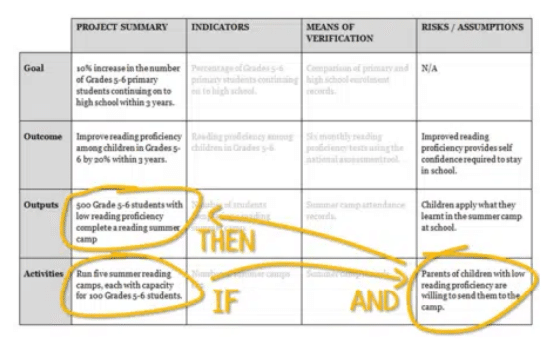
ToCかLogframeかどっちもか?(2023年9月執筆)
9月13日にICAIからUKAidのレビューが出ており、早速読みたいところではあるものの、筆者が個人的にやるやる詐欺をしていたToCとLogframeのまとめをいい加減に片付けないと未来の自分に怒られそうなので、こちらを先に片付けてレビューは次に回します。
そもそもToCとLogframeをご存知でないと一体ナンノコッチャとなってしまいますが、どちらもプロジェクトの方法論みたいなものです。ちゃんとした解釈は後に続きますので悪しからず。国際開発の世界に入れば必要になってくるものなので、実際の作成方法やこれらの方法論が使われてきたバックグラウンドを知っておかねばなりませんなーという話です。筆者も学部では一ミリも知らなかったので、修士で初めて耳にして基礎知識が無いことに絶望して穴があったら入りたくなった記憶があります。
まずToC、つまりTheory of Changeですが、アイデアを広めたうちの一人で挙げられるCarol Weiss (1995)は、“a theory of how and why an initiative works.”と表現しています。このアイデアはどこから生まれたかと言うと、Vogel (2012)によると、”Recently developed planning approaches such as Outcome Mapping formally involve stakeholders and strategic partners in the elaboration of theories of change“としており、Outcome MappingはToCに繋がっているらしい。Outcome Mappingは、“premised on the perspective that development is about people and so collectively exploring the changes that an initiative might directly influence in stakeholder behaviour, relationships and the wider environment is the first step in understanding wider changes that might then unfold”であり、そのプロセスがToCを作り上げているという認識でしょうか。ToCについてもう少し具体的に見ていきま すと、Valters and Stein (2012)は、ToCは4つの中心的な使い方があるとしています:
Strategic planning: ToC helps organisations practically to map the change process and its expected outcomes and facilitates project implementation. For these purposes, ToC is often used in conjunction with logframe approaches. 26
Monitoring and evaluation: ToCs articulate expected processes and outcomes that can be reviewed over time. This allows organisations to assess their contribution to change and to revise their ToC.27
Description: ToC allows organisations to communicate their chosen change process to internal and external partners. A simple description of an organisation’s ToC can be understood as minimal way of engaging with ToC.28
Learning: ToC helps people to clarify and develop the theory behind their organisationor programme.This relates to an understanding of ToC as a thinking tool.
1つ目はつまるところToCはコンパスみたいなものでプロジェクトをガイドしてくれる意味合いがあります。monitoring and evaluationとlearningについては、プロジェクトに何かしらの”change”があったらどうなるかという仮説であって、必要であればToCを書き換え可能とされています。この何かしらのchangeについては、Hivos (Humanist Institute for Co-operation with Developing Countries)のダイアグラムが分かりやすい。
3つ目のdescriptionは、上のVogelの引用にもあるように、利害関係者(というかdonors)にプログラムの説明をするというシンプルな目的です。それぞれ重なっている部分もあるようで、文中に”these inevitably overlap”とありますし、それぞれ厳格に4つに分ける必要はなくdefinitiveな答えではないと明記しています。Hivosはこれらに加え、プロジェクトデザインやQA、knowledge mappingなどを挙げています。


ToCについては、Hivosのガイドラインを読むのが全体像掴むには良いんじゃないでしょうか。本稿でまとめるまでもなくソース(Van Es et al (2015))読んでいただいたほうが分かりやすいと思います(訳すのが面倒くさいしステップ8つ分をまとめるのは気が進まない)。
つづいてlogframe(Logical Framework)ですが、4×4のマトリックスとなっています。

Gasper(2000)のthe logical framework approach (LFA)の定義はこちら:
“The LFA is an attempt to think in an integrated way about: a) project objectives, distinguishing various levels; b) the causal linkages between these levels; c) the factors in the project’s environment that are needed for the linkages to be valid; and d) how to assess the degree of fulfilment of the various objectives.”
ToCがcasual pathwaysを示すのに対して、logframeはactions, outputs, outcomes、ベースの進捗をモニタリングする色合いが強いです。ToCはoutcomesの”何故”の部分を描いておりますけれども、loframeはそこに関心を置いておらず、あくまでリソースをどこそこに使って、“こうしたら”最終的に”こうなります”を伝えるのに特化しています。Eyben et al.(2008)がlogframeに関してsimplisticで”linear cause-effect thinking”の傾向があり、過程の複雑さを無視していると批評しているように、端的に表現すると”ToCは複雑な変化に対処できるがlogframeはシンプルすぎる“です。また、Vogel(2012)は、logframeの問題点を、
“…the log-frame as it is currently used hides what many interviewees called a ‘missing middle’ – how the immediate results of a programme influence changes at other levels to influence outcomes and impact in the longer-term.
としており、上のHivosのToCのダイアグラムの間に当たる部分が抜けているという批判ですね。ただ、ToCも万能ではなく、Prinsen&Nijhof(2015)が実際に作成された15のToCを分析した結果、プラクティカルな面で障壁多いんじゃない?とまとめておりますし、Vogel(2012)のプラクティカルな側面から上記のシンプルさはlogframeの強みでもありまして、DFIDは2011年に”Guidance on using the revised Logical Framework”というペーパーを出しており、Since the logframe is an integral element of the business Case all newly approved projects regardless of project value must also now contain a logframe”と言及しています。
生まれた順番としてはlogframeが先輩(1970年頃)で、ToCが上記のlogframeの不足分を補う形で存在感を増してきた背景があります。ToCとlogframeの地元は同じなので、どっちやねんクエスチョンは分かりづらくて当たり前、というのはVogel(2012)もおっしゃっていますね。とはいえどっちを使うか、両方使うか決める必要がありますし、そうすると使い分けを考えなければいけません。ToCとlogframeを完結に述べると、
ToC:最終的なchangeまでのcasual relationsにフォーカスしてプロジェクトロジックを説明する
Logframe: プロジェクトの施策、影響やインパクトレベルを測定し、リソースマネジメントできる仕組みを作る
というような役割分担になってきます。プロジェクトのロジックをクリアに伝えるためにもToCは必要不可欠であり、プロジェクトのスターティングポイントとして利用しつつ、logframeはシンプル化したToCして有効活用できるのでは?というアイデアがあります。ToCでプロジェクトのロジックを説明しつつ、logframeはリソースマネジメントとか測定のツールとして使えば良いでしょという見解がありますので、ToCで現状理解を深めて、それを基にlogframeを作り上げるという流れですね。Vogel(2012)も指摘しているように、現場の人的・タイムリソースには限りがあるので、ToCはlogframeの”robust”な性質をお借りして、資金や機関のサポートを充実させたほうが良いと述べています。
では実際開発援助機関ではToCとlogframeのミックスでやっていってるんですか?という問に行き着きますが、DFIDのSmart Rules (DFIDプログラムのフレームワーク)にもToCとlogframe (Smart Rulesではresults frameworkという名称になっているがフォーマットはlogframe)について書かれてますし、logframeはTocにリンクして作られることが求められています。FCDOになってからもFCDO’s Programme Operating Framework (PrOF)と名称は変わっていますが、results frameworkはチェック対象でToCもPrOFのgood practice guidesに入っていますね。devtrackerで適当にプログラムを選んで探しましたところ確かにありました。results frameworkはドキュメント内にはありませんでしたが、作成されているようです。

実際にどうやってドキュメント作っていくんですかというのは、Davies(2018)に書いてあるみたいなのでもう時間が厳しくなってきたので、未来の自分が後で読んでくれるでしょう。役立ちそうなツール(資料)集載せてお くので許してもらえるはず:
https://tools4dev.org/
https://mande.co.uk/ https://www.betterevaluation.org/ https://www.intrac.org/resources/me-universe/ https://odi.org/en/about/features/communications-monitoring-evaluation-and-learning-toolkit/
References (記事内ハイパーリンクは載せてません):
Davies., R. (2018). Representing Theories of Change: A Technical Challenge with Evaluation Consequences, CEDIL Inception Paper 15: London
Eyben, R., T. Kidder, J. Rowlands, and A. Bronstein. (2008). “Thinking About Change for Development Practice: A Case Study from Oxfam GB.”Development in Practice 18 (2): 201–12.
Prinsen, G., & Nijhof, S. (2015). Between logframes and theory of change: reviewing debates and a practical experience, Development in Practice, 25:2, 234-246, DOI: 10.1080/09614524.2015.1003532
Stein, D., & Valters, C. (2012). Understanding Theory in Change in International Development. The Asia Foundation. Retrieved from http://eprints.lse.ac.uk/56359/1/JSRP_Paper1_Understanding_theory_of_change_in_international_development_Stein_Valters_2012.pdf
Van. Es, M., Guijt, I., & Vogel, I. (2015). ‘Hivos ToC Guidelines: Theory of Change Thinking in Practice’. Retrieved from: https://hivos.org/document/hivos-theory-of-change/
Vogel, I. (2012). Review of the use of ‘Theory of Change’ in international development Review Report. Retrieved from: https://www.theoryofchange.org/pdf/DFID_ToC_Review_VogelV7.pdf
Weiss, C. H. (1995). Nothing as practical as good theory: Exploring theory-based evaluation for comprehensive community initiatives for children and families. In J. Connell, A. Kubisch, L. Schorr & C. Weiss (Eds.), New approaches to evaluating comprehensive community initiatives (pp. 65-92). New York: The Aspen Roundtable Institute.
この記事が気に入ったらサポートをしてみませんか?
